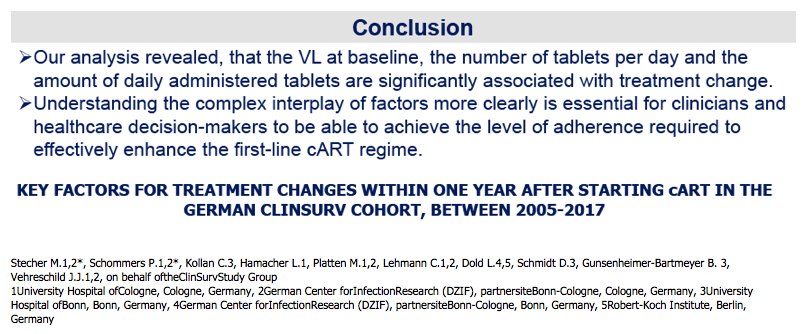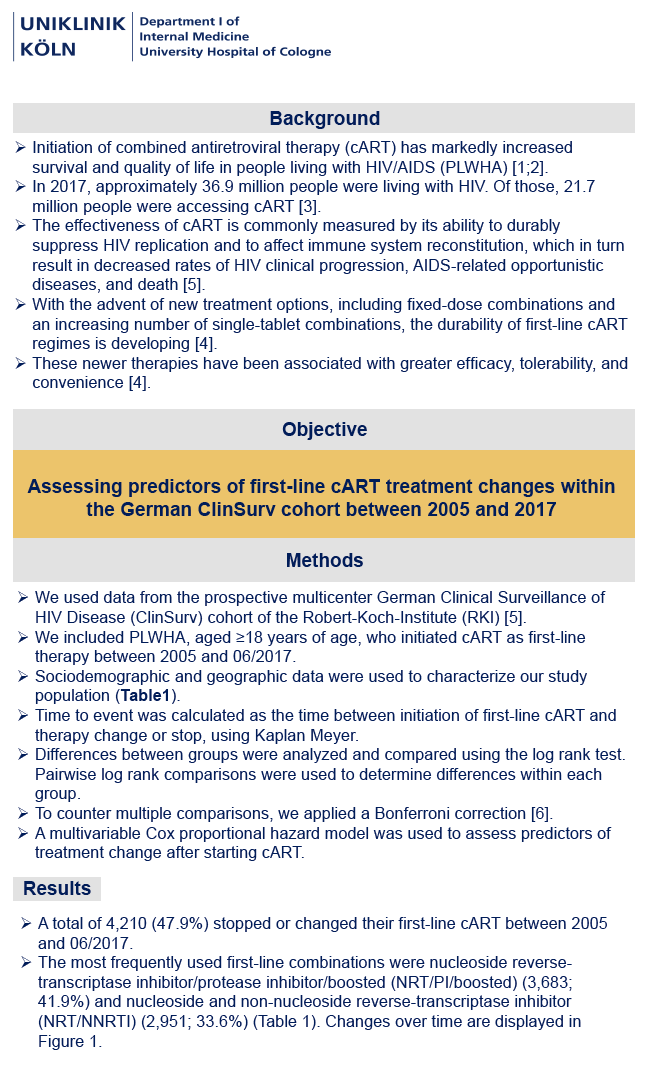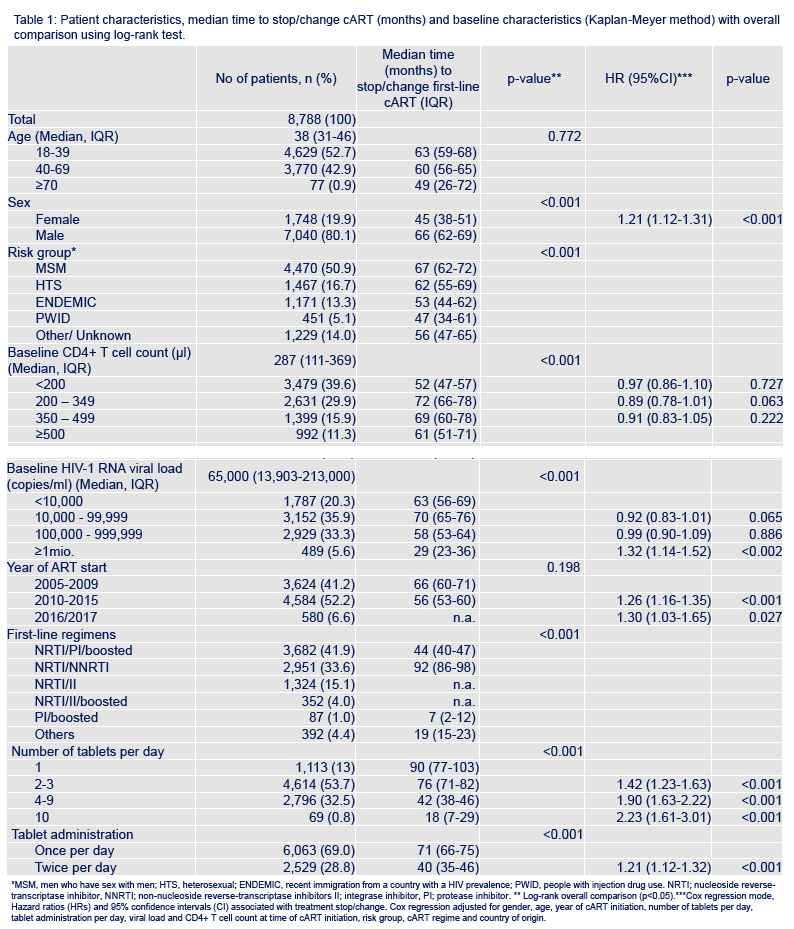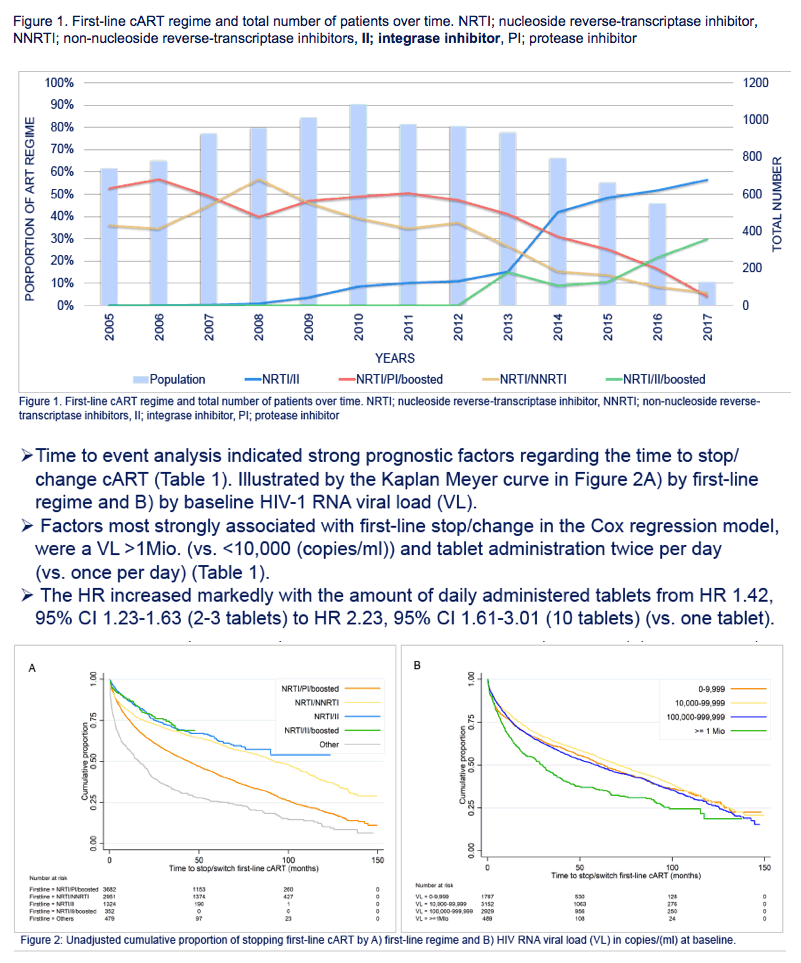 |
 |
 |
| |
Key factors for treatment changes within one year after starting ART in the German ClinSurv Cohort; between 2005 and 2017: Higher Pretreatment Load, More Pills Predict Faster ART Stop or Switch
|
| |
| |
IDWeek 2018, October 3-7, 2018, San Francisco
"The HR increased markedly with the amount of daily administered tablets from HR 1.42, 95% CI 1.23-1.63 (2-3 tablets) to HR 2.23, 95% CI 1.61-3.01 (10 tablets) (vs. one tablet)."
Mark Mascolini
A high pretreatment viral load, more pills, and more than 1 daily dose predicted faster time to stopping or switching a first antiretroviral therapy (ART) regimen in an 8788-person German cohort [1]. People stopped integrase inhibitor regimens and nonnucleoside combinations less often than boosted protease inhibitor (PI) regimens.
German ClinSurv clinicians who conducted this study noted that a flood of fixed-dose antiretroviral combinations and single-tablet regimens enhanced the durability of first-line therapy and promoted sustained viral suppression over the past several years. They analyzed their prospective cohort to identify predictors of first-line ART changes--including stops or switches--between 2005 and 2017.
The research team focused on people at least 18 years old who started first-line ART from 2005 through June 2017. They used Kaplan-Meier analysis to calculate the time between starting ART and the first regimen stop or switch. Multivariable Cox proportional hazards models assessed predictors of treatment stop or switch.
The analysis included 8788 people, 53% of them 18 to 39, 43% 40 to 69, and 1% 70 or older. Median time to stop or switch was 63 months in the youngest group, 60 months in the middle age group, and 49 months in the 70-or-older group (P = 0.772). Almost half of cohort members (47.9%) stopped or switched first-line ART during the 12-year study period.
Women stopped or switched significantly faster than men (median 45 versus 66 months, P < 0.001), and the Cox model determined that women had a 21% higher risk of stopping or switching (hazard ratio [HR] 1.21, 95% confidence interval [CI] 1.12 to 1.31, P < 0.001). Among HIV transmission groups, people who injected drugs or recently emigrated from a high-prevalence country stopped significantly faster than other groups (47 or 53 months versus 62 or 67 months, P < 0.001).
People with a pretreatment viral load of 1 million or more copies stopped significantly sooner than those with a pretreatment load below 10,000 copies (29 versus 63 months, P < 0.001). Multivariable analysis determined that people with a 1-million-plus pretreatment load had a 32% higher chance of stopping than the under-10,000 group (HR 1.32, 95% CI 1.14 to 1.52, P < 0.002). This analysis did not find a greater risk of stopping with a pretreatment load of 10,000 to 99,999 copies or 100,000 to 999,999 copies versus under 10,000 copies.
Compared with starting a single-tablet regimen (median 90 months to stopping), those starting more tablets stopped significantly faster: 76 months for 2 or 3 tablets (HR 1.42, 95% CI 1.23 to 1.63, P < 0.001), 42 months for 4 to 9 tablets (HR 1.90, 95% CI 1.63 to 2.22, P < 0.001), and 18 months for 10 or more tablets (HR 2.23, 95% CI 1.61 to 3.01, P < 0.001). People starting a twice-daily regimen stopped in a median of 40 months, compared with 71 months for a once-daily combination (HR 1.21, 95% CI 1.12 to 1.32, P < 0.001).
In the ClinSurv cohort, boosted and unboosted integrase inhibitors began displacing nonnucleosides and PIs as the most frequent first regimens in 2013. Kaplan-Meier analysis showed much greater first-line durability with an integrase inhibitor or a nonnucleoside than with a boosted PI (median 92 months with nonnucleoside versus 44 months with boosted PI, P < 0.001; median time with integrase inhibitors not calculated; hazard ratios not calculated).
The ClinSurv investigators proposed that "understanding the complex interplay of [stop or switch] factors more clearly is essential for clinicians and healthcare decision-makers to be able to achieve the level of adherence required to effectively enhance the first-line cART regime."
Reference
1. Stecher M, Hamacher L, Platten M, et al. Key factors for treatment changes within one year after starting ART in the German ClinSurv Cohort; between 2005 and 2017. IDWeek 2018, October 3-7, 2018, San Francisco. Abstract 580. Poster at https://idsa.confex.com/idsa/2018/webprogram/Paper70660.html





|
| |
|
 |
 |
|
|